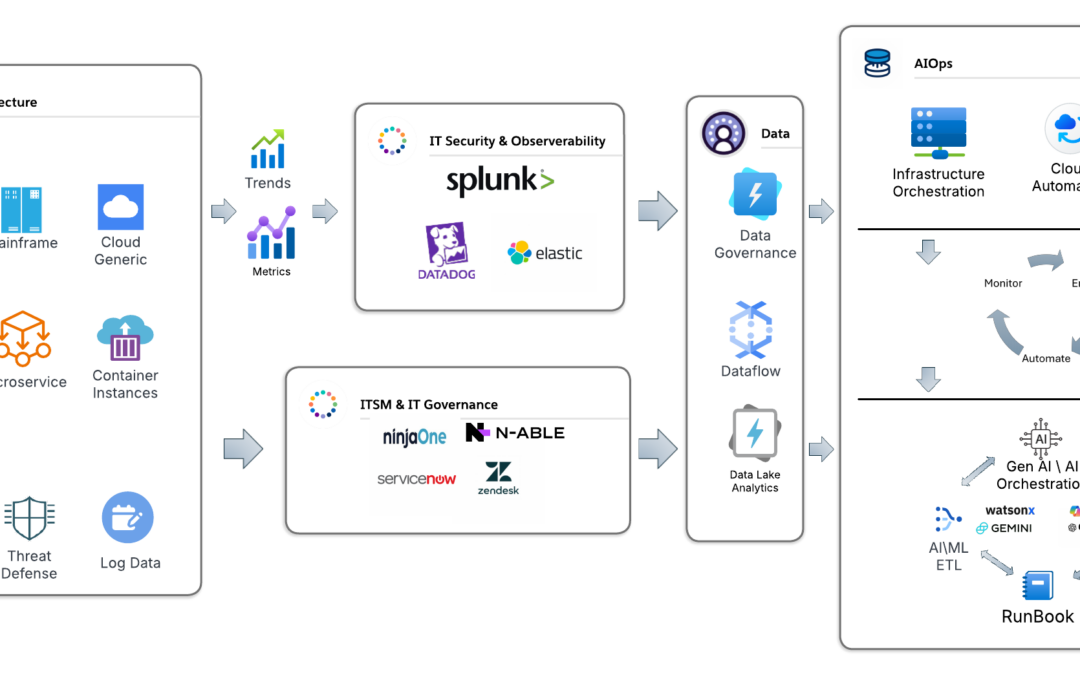In today’s digital-first environment, IT systems are more complex than ever. Between hybrid infrastructure, legacy applications, microservices, and growing security demands, operations teams are being pushed to their limits. That’s where AIOps—Artificial Intelligence for IT Operations—comes in.
AIOps is more than just a toolset. It’s a strategy for transforming how organizations manage, monitor, and optimize their IT environments by leveraging artificial intelligence, machine learning, and real-time data analytics. At its core, AIOps automates the heavy lifting in IT—surfacing insights, predicting issues, and enabling faster, more accurate responses.
The AIOps Lifecycle: Monitor, Automate, Engage
A successful AIOps strategy follows a dynamic loop: Monitoring, Automating, and Engaging. As shown in the visual above, this cycle starts with data—both historical and real-time—which feeds intelligent systems capable of:
- Detecting anomalies before they escalate into outages
- Automating responses to common incidents and performance issues
- Engaging teams with actionable insights for continuous improvement
This feedback loop empowers organizations to move from reactive to proactive operations, creating a smarter, more resilient digital ecosystem.
Key Business Outcomes of AIOps
By intelligently correlating vast volumes of telemetry, log data, and system alerts, AIOps helps organizations achieve real, measurable outcomes:
- DevOps Acceleration: AIOps boosts CI/CD pipelines by identifying bottlenecks and automating rollbacks or remediation steps.
- Predictive Analytics: Machine learning uncovers trends and patterns to forecast system behavior, reducing downtime and unplanned outages.
- Streamlined Support: AI cuts through alert noise and prioritizes tickets, saving thousands of hours in incident response.
- Proactive Anomaly Detection: Instead of reacting to symptoms, AIOps helps identify root causes instantly.
- Performance Monitoring: Continuous analysis keeps systems tuned and aligned with business service levels.
Research shows that adopting AIOps can reduce IT operating costs by up to 30%, cut incident response times in half, and significantly improve customer satisfactionMarket Analysis-AIOps.
Not Just for Tech Giants: Industry-Wide Relevance
While AIOps began in high-tech enterprises, its benefits now span industries:
- Finance: Enhances availability of critical banking services and detects fraud faster.
- Healthcare: Ensures uninterrupted access to patient records and clinical applications.
- Telecom: Automates network fault detection and capacity optimization.
- Retail & E-commerce: Supports high availability during traffic surges and flash sales.
- Federal Agencies: Aligns with modernization mandates, streamlines cybersecurity operations, and supports Zero Trust initiativesAIOps Stratagy.
Even organizations with lean IT teams are seeing the benefits of AIOps by deploying modular, plug-and-play solutions tailored to their environments.
Building an AIOps Strategy
Whether you’re just getting started or looking to scale, here are a few strategic steps to consider:
- Start with the Right Data: Clean, structured, and connected data is the fuel of AIOps. Collect logs, metrics, events, and telemetry from across your stack.
- Automate the Routine: Begin by targeting high-volume, low-value tasks like ticket routing, alert triage, and system checks.
- Integrate Across Teams: Break down silos between ITOps, DevOps, and SecOps. AIOps works best when it spans the full lifecycle.
- Measure What Matters: Use KPIs such as Mean Time to Detect (MTTD), Mean Time to Resolve (MTTR), alert volume reduction, and SLA adherence to demonstrate value.
Final Thoughts
AIOps isn’t a silver bullet—it’s a strategic enabler for modern IT operations. It helps organizations evolve from fire-fighting to foresight, from manual tasks to intelligent automation, and from siloed systems to unified observability.
As the pace of digital transformation accelerates, AIOps offers a critical path forward. Whether you’re aiming to boost uptime, reduce cost, or improve customer experience, now is the time to explore how AI-driven operations can reshape your IT future.





